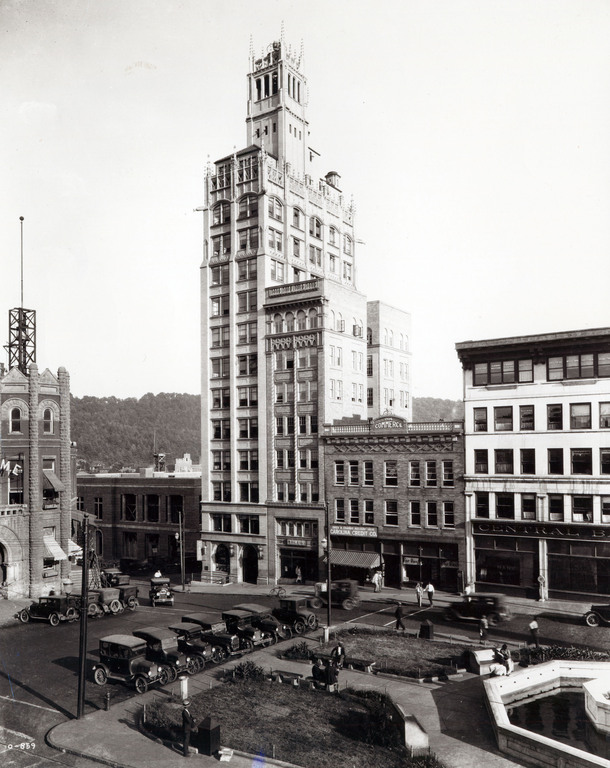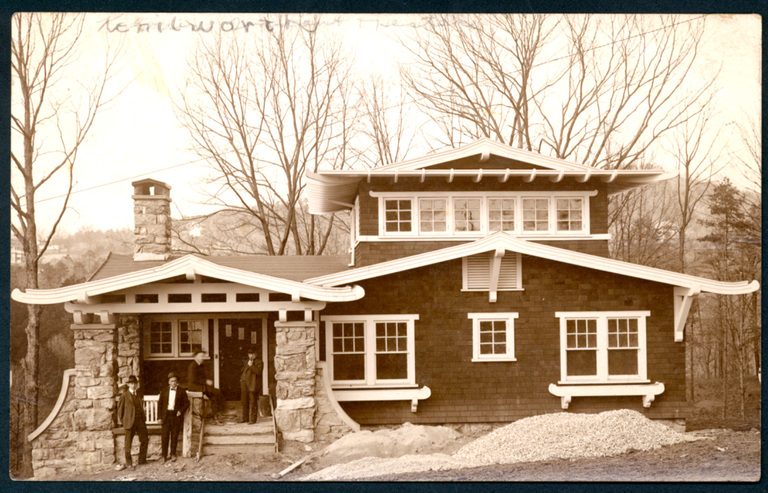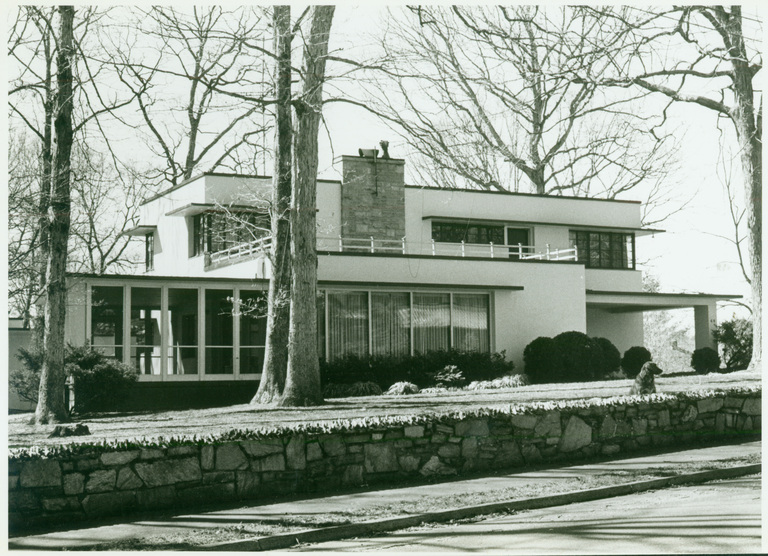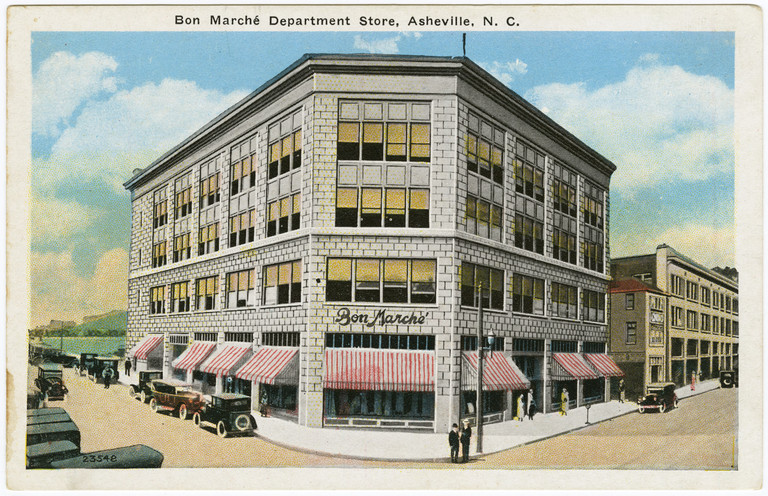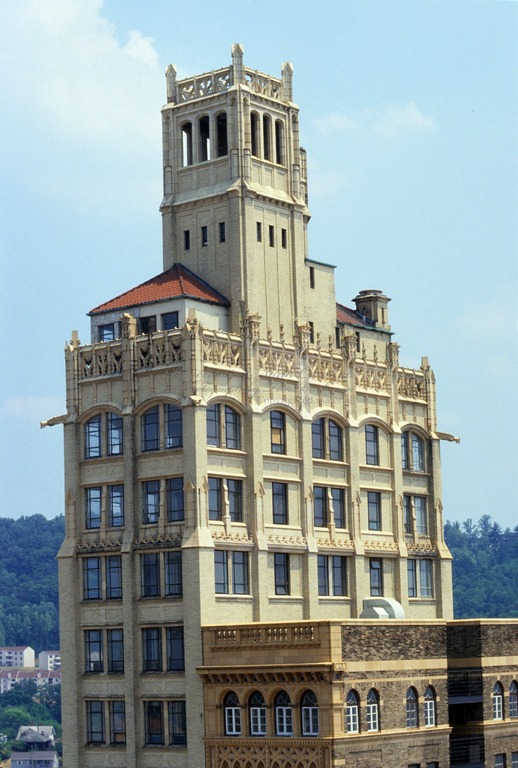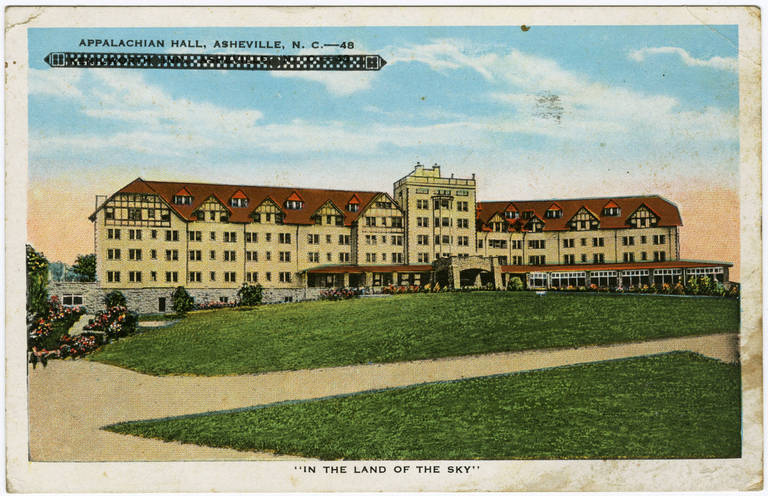Greene, Ronald (1891-1961)
Birthplace:
Coldwater, Michigan, USA
Residences:
- Asheville, North Carolina
- Gastonia, North Carolina
Trades:
- Architect
Building Types:
Styles & Forms:
Colonial Revival; Gothic Revival; Modernist; Rustic; Spanish Colonial Revival; Tudor Revival
Ronald Greene (May 11, 1891-October 11, 1961) numbered among the leading architects during Asheville’s architectural heyday of the 1910s and 1920s and is best known as the designer of the mountain city’s first skyscraper—the slender, Gothic Revival style Jackson Building (1923-1924). During a long and distinguished career, he frequently took advantage of local publications to promote his practice and worked in a wide variety of styles. Continuing to work in Asheville through the Great Depression and beyond, in 1951 he moved to Gastonia and practiced in that city. He affiliated at different times with other architects including Robert L. Kane in the mid-1920s; W. Stewart Rogers (Greene and Rogers) in the 1930s; and Milton Robelot of Kingsport, Tennessee in the firm of Greene and Robelot of Asheville and Kingsport, formed in 1948. Greene was a founding member of the Architect’s Association of Western North Carolina along with ten other architects from the region and served as its president.
Born in Coldwater, Michigan, to Dr. Lyman and Jennie Greene, Ronald is described in family accounts as having come to Asheville by 1916. An article of 1926 in The Southern Tourist, based on an interview with him, stated that he was educated and worked for a time as an architect in New York and in Cleveland before arriving in Asheville. According to the Asheville Citizen of January 16, 1926, while in Michigan Greene was hired by a furniture manufacturing company to design a factory in western North Carolina in the 1910s and fell in love with the region.
Greene evidently came to Asheville as supervising architect for the spectacular Tudor Revival style Kenilworth Inn II built by the Carolina Wood Products Company (which made furniture and other wood products) on the outskirts of Asheville. The Asheville Times of February 28, 1921, based on information from Greene, stated that he was “formerly chief architect for the Carolina Wood Products Company” and architect for several local buildings “including the Carolina Apartments, Homewood development in Grove Park, and the Kenilworth development.” After the original Kenilworth Inn I of 1890 burned in 1909, developer James Chiles and others organized the Kenilworth Company to build a new inn by the same name as centerpiece of a residential development called Kenilworth. On November 3, 1916, the Kenilworth Company contracted with Carolina Wood Products Company, a Michigan-based business with offices and a furniture and building materials factory in Asheville, to construct the massive inn, and an agreement of November 13 credited the design to “the firm of Donaldson & Meir of Detroit, Michigan and Roland [sic] Greene of Asheville.” In 1917 the Asheville city directory listed Ronald Greene as “chief engineer” for the Carolina Wood Products Company. Greene designed the firm’s Carolina Apartments (1918) as one of the first modern apartment houses in town. Shortly after this he moved to Minnesota where he spent two years with the United States Steel Corporation in Duluth.
In an article headed “Well Known Architect Locates in Asheville/ Ronald Greene, Once Engaged in Architectural Work Here, Will Locate Permanently,” surely based on information provided by Greene, the Asheville Times of February 28, 1921 gave details of his work in Duluth, where he was “engaged as architect by the United States Steel Corporation” and designed many churches, hotels, residences, and business buildings. “One of the most interesting achievements of the young architect was the removal of the town of Hibbing, Minn. It was discovered that beneath the heart of the city were large and rich deposits of iron ore sufficient to warrant the removal of the entire town, at that time totaling over 16,000 inhabitants.” (As described in Wikipedia, the town of Hibbing was indeed removed from that site and rebuilt not far away; the architect for the rebuilding is not mentioned in that source.) The 1921 article credited Greene with “the erection of hundreds of new residences, apartment houses, a large commercial hotel, school buildings, fireproof hospital . . ., lodge buildings for the Masons and the Elks and a number of commercial buildings [in new Hibbing]. Besides this work, Mr. Greene designed in Duluth a large Gothic church and the country club.” He was reportedly “associated with” a Chicago architect in planning a large apartment hotel in Chicago.
In deciding to return to Asheville early in 1921, Greene was surely aware of the city’s mounting building boom. The Southern Tourist writer of 1926 wound up his interview with the architect thus: “‘And now, Mr. Greene,’ said I, ‘no doubt you came to Asheville for your health, did you not?’ ‘Yes, I did not,” replied Mr. Greene, ‘I came here because I like the mountains and there was opportunity. There was absolutely nothing the matter with my health.’”
The Southern Tourist writer also noted that clients from New York, Chicago, and Cleveland had “come to North Carolina to employ him on their work.” Likely encouraged by Greene, the writer pointed to a statement by national architectural critic Fiske Kimball in Architectural Record, which described recent skyscrapers in New York as lacking in boldness and distinction but said, “A notable exception is the Jackson Building in Asheville, in which Mr. Ronald Greene has arrived at simple and successful composition with Gothic forms.” The Jackson Building instantly became a signature building for the city and the architect.
Working in a broad range of styles and building types with the panache that suited Asheville’s spirit, Greene designed buildings that helped create the city’s distinctive architectural character in the 1920s. These included the Westall Building (1924-1925) adjoining the Jackson Building, the Longchamps Apartment (1925) in a dramatic mountainside chateau form; the classically composed Claxton School (1922-1925); and residences in a wide range of styles from Tudor to Georgian Revival to rustic to bungalows. As developers established suburbs during western North Carolina’s boom years, Greene designed more houses in Chiles’s Kenilworth suburb and served as consulting architect for Sulphur Springs Park near Asheville and Druid Hills at Hendersonville.
After the Crash of 1929, architectural prospects in Asheville dropped off dramatically. Nonetheless, by about 1934 Greene had sufficient work to employ in his office the young architect W. Stewart Rogers, a recent M. A. in architecture from Harvard who had grown up in Asheville. (For a few years Rogers was listed as working for Ronald Greene, Ltd., but by the end of the decade the firm was listed as Greene and Rogers. Works produced during their entire association are cited to Greene and Rogers in the building list.) A welcome project in the mid-1930s was the Howard Gamble House (1935) in Durham, a striking International Style design with rectilinear forms that expressed Mr. and Mrs. Gamble’s interest in modern art and architecture. Its modernist character has been attributed to Rogers and the influence of his Harvard training. The house, quite innovative in Durham and North Carolina at the time, was featured in national magazines and likely inspired several copies. Like most of his contemporaries, Greene also liked to keep abreast of new trends and could work equally happily in revivalist and modern styles. Along with many other architects, Greene and Rogers found work in projects assisted by the Public Works Administration, including Madison Dormitory (1939) in simple Colonial Revival style at present Western Carolina University in Cullowhee.
As the Depression eased, more private work became available, and Greene and Rogers together and separately designed numerous buildings. The firm made sure that Asheville newspaper articles on renewed construction in the mid to late 1930s regularly featured their projects (see building list). One account in 1939 noted “something of a spurt” in home building in the area, including several substantial residences planned by Greene and Rogers in Biltmore Forest and various Asheville suburbs. Especially notable is Greene’s Snowbird Mountain Lodge (1940-1941), one of the last rustic mountain lodges built before World War II. Located on a mountain top amid miles of forested slopes including the surviving old-growth Joyce Kilmer National Forest, it was built for a Chicago travel agent to accommodate passengers on his railroad and bus tours of the mountains.
At the beginning of World War II, Greene and Rogers went their separate ways, with Rogers affiliating with Six Associates in 1942. One of Greene’s notable works in the immediate postwar era was the modernist Annie Reed House of 1948 (a clean-lined, asymmetrical design akin to the earlier Gamble House in Durham), which stood out in its Asheville neighborhood of picturesque residences.
In 1951 Greene moved to the bustling textile manufacturing town of Gastonia. His projects encompassed a wide range of building types from the First Union Bank to several health facilities and residences. Greene attended St. Mark’s Episcopal Church in Gastonia and was a member of the local Rotary Club and a Mason. At his death he left his widow, Louise, of Gastonia, and three children, Mrs. George S. Mackelfresh and Mrs. George D. Wilson of Charlotte, and Nelson R. Green, of Charlotte. He was buried in Gaston Memorial Park.
- Asheville Citizen, Oct. 12, 1961.
- Catherine W. Bishir and Michael T. Southern, A Guide to the Historic Architecture of Piedmont North Carolina (2003).
- Catherine W. Bishir, Michael T. Southern, and Jennifer F. Martin, A Guide to the Historic Architecture of Western North Carolina (1999).
- Carolina Architecture and Allied Arts: A Pictorial Review of Carolina’s Representative Architecture (1940).
- Clippings file, Ronald Greene, Pack Memorial Library, Asheville, North Carolina.
- Davyd Foard Hood, “Snowbird Mountain Lodge,” National Register of Historic Places nomination (1993).
- Korey Maney, “Kenilworth Inn,” National Register of Historic Places nomination (2001).
- The Southern Tourist (Mar. 1926).
8 Bowling Park Rd.
Contributors:Ronald Greene, architectDates:1917
Location:Asheville, Buncombe CountyStreet Address:8 Bowling Park Rd., Asheville, NC
Status:Unknown
Type:Residential
Note:The image shows a “Real Photo” postcard of a house built by James Chiles at 8 Bowling Park Rd. Written on back: “Greene, Tennant, Hester (with pipe.)” Pack Memorial Library. The photo was published in ad for Carolina Wood Products Company in the Asheville Citizen Times, March 25, 1917. Greene was likely architect Ronald Greene and Hester was Eugene Hester, who in the 1917 Asheville city directory is listed as president of the Kenilworth Development Co. “Tennant” might be builder J. A. Tennant, who died in 1916, or his son, George. The fourth man is not identified.
Annie Reed House
Contributors:Ronald Greene, architectDates:1948
Location:Asheville, Buncombe CountyStreet Address:68 Kenilworth Rd., Asheville, NC
Status:Standing
Type:Residential
Images Published In:Douglas Swaim, ed., Cabins and Castles: The History and Architecture of Buncombe County, North Carolina (1981).
Note:Like Greene’s earlier Howard Gamble House in Durham, the horizontally composed, asymmetrical modernist house features rectilinear forms and was a departure from the community’s generally revivalist residential architecture.
Asheville Municipal Building
Contributors:Samuel I. Bean, stone and tile contractor; Ronald Greene, architect; James Vester Miller, attributed contractorDates:1925-1926
Location:Asheville, Buncombe CountyStreet Address:100 Court Plaza, Asheville, NC
Status:Standing
Type:Public
Note:The 2-story, dark red brick-faced building with limestone trim which replaced the former city hall on this site had a market at the basement level and now houses the local police and fire department. Strong family tradition attributes its construction to James Vester Miller.
Bon Marche Department Store
Contributors:Ronald Greene, architect; Luther L. Merchant, contractorDates:1937
Location:Asheville, Buncombe CountyStreet Address:33 Haywood St., Asheville, NC
Status:Altered
Type:Commercial
Note:Pack Memorial Library in Asheville has Greene’s architectural drawings for Bon Marche.
Buncombe County Training School
Contributors:Ronald Greene, architectDates:1928
Location:Asheville, Buncombe CountyStreet Address:County Farm Road (Erwin Hills Road), Asheville, NC
Status:Standing
Type:Educational
Note:A castle-like edifice in stone and brick.
C. I. Dawson House
Contributors:Dates:1936
Location:Asheville, Buncombe CountyStreet Address:1 N. Colonial Pl., Asheville, NC
Status:Standing
Type:Residential
Note:“Colonial style bungalow costing about $10,000, in Residences Costing More Than $150,000 Being Constructed Here (Asheville Citizen, Aug. 2, 1936).
C. L. Kellogg House
Contributors:Ronald Greene, architectDates:1936
Location:Asheville, Buncombe CountyStreet Address:115 Westwood Rd., Beaver Lake, Asheville, NC
Status:Unknown
Type:Residential
Note:“Stone and frame and cost approximately $5,000,” “recently completed,” in “Residences Costing More Than $150,000 Being Constructed Here” (Asheville Citizen, Aug. 2, 1936).
Carolina Apartments
Contributors:Ronald Greene, architectDates:1918
Location:Asheville, Buncombe CountyStreet Address:68 N. French Broad Ave., Asheville, NC
Status:Standing
Type:Residential
Note:Asheville’s first modern luxury apartment building, it was a project of the Carolina Wood Products Company, which also built the Kenilworth Inn II.
Charles M. Britt House
Contributors:Dates:1936
Location:Asheville, Buncombe CountyStreet Address:304 Kimberly Ave., Asheville, NC
Status:Standing
Type:Residential
Note:“Residences Valued At $200,000 Are Being Built” (Asheville Citizen, Nov. 18, 1936). The photo in the newspaper showed an 8-room house of frame and stone.
Claxton School
Contributors:Ronald Greene, architectDates:1922
Location:Asheville, Buncombe CountyStreet Address:241 Merrimon Ave., Asheville, NC
Status:Standing
Type:Educational
Note:An article on the “North Asheville School Building as it Will appear Completed” (Asheville Citizen, Sept. 3, 1922) featured the architect’s rendering.
Curtis and Florence Bynum House
Contributors:Ronald Greene, architectDates:1923-1924
Location:Asheville, Buncombe CountyStreet Address:200 Macon Ave., Asheville, NC
Status:Standing
Type:Residential
Images Published In:Douglas Swaim, ed., Cabins and Castles: The History and Architecture of Buncombe County, North Carolina (1981).
Note:A stone Tudor Revival style residence.
Ed Hartshorn House
Contributors:Dates:ca. 1937
Location:Asheville, Buncombe CountyStreet Address:320 Vanderbilt Rd., Biltmore Forest, Asheville, NC
Status:Unknown
Type:Residential
Ethan Koon House
Contributors:Dates:1936
Location:Asheville, Buncombe CountyStreet Address:185 Kimberly Ave., Asheville, NC
Status:Standing
Type:Residential
Gay Green and Effie Reeves House
Contributors:Dates:1930s
Location:Asheville, Buncombe CountyStreet Address:152 Pearson Dr., Asheville, NC
Status:Standing
Type:Residential
Images Published In:Michael T. Southern, Asheville’s Historic Montford, Asheville, North Carolina (1985).
Note:The formal Colonial Revival house was featured in Carolina Architecture and Allied Arts: A Pictorial Review of Carolina’s Representative Architecture (1940).
Herbert Hix House
Contributors:Ronald Greene, architectDates:1936
Location:Asheville, Buncombe CountyStreet Address:44 Lakewood Dr., Kenilworth, Asheville, NC
Status:Unknown
Type:Residential
Howard Gamble House
Contributors:Dates:1935
Location:Durham, Durham CountyStreet Address:1307 N. Mangum House, Durham, NC
Status:Standing
Type:Residential
Images Published In:Catherine W. Bishir and Michael T. Southern, A Guide to the Historic Architecture of Piedmont North Carolina (2003).
Note:Built for a family interested in modern art and architecture, the Gamble House is one of the earliest North Carolina residences in modernist style. It was featured in national magazines and noted among Durham’s “points of interest.” It is somewhat similar to Ronald Greene’s Annie Reed House (1948) in Asheville.
J. Hobart Allport House
Contributors:Ronald Greene, architectDates:1922
Location:Asheville, Buncombe CountyStreet Address:46 St. Dunstan’s Circle, Asheville, NC
Status:Standing
Type:Residential
Jack and Ruth Barfield House
Contributors:Ronald Greene, architectDates:1939-1940
Location:Asheville, Buncombe CountyStreet Address:36 N. Griffing Blvd., Asheville, NC
Status:Standing
Type:Residential
Images Published In:Carolina Architecture and Allied Arts: A Pictorial Review of Carolina’s Representative Architecture (1940).
Jackson Building
Contributors:Dates:1923-1924
Location:Asheville, Buncombe CountyStreet Address:22 South Pack Square, Asheville, NC
Status:Standing
Type:Commercial
Images Published In:Catherine W. Bishir, North Carolina Architecture (1990).
Catherine W. Bishir, Michael T. Southern, and Jennifer F. Martin, A Guide to the Historic Architecture of Western North Carolina (1999).
David R. Black, Historic Architectural Resources of Downtown Asheville, North Carolina (1979).
Douglas Swaim, ed., Cabins and Castles: The History and Architecture of Buncombe County, North Carolina (1981).Note:The slender 13-story building on a tiny lot was the first skyscraper in western North Carolina. Designed by architect Greene for young real estate developer L. B. Jackson, the steel-framed brick building features elaborate glazed terra cotta ornament in a Gothic Revival style that emphasizes its height. It stands on the lot where Thomas Wolfe’s father had his monument shop. Originally, the building had more spires and a searchlight on top that cast a beam for 30 miles.
James Madison Chiles and Leah Chiles House
Contributors:Ronald Greene, architectDates:1922-1926
Location:Asheville, Buncombe CountyStreet Address:21 Chiles Ave.
Status:Standing
Type:Residential
Note:The large, richly detailed villa in exotic Spanish-inspired style was built for the developer of the Kenilworth suburb and his wife, Leah, who became an important local leader, including as Asheville’s first female mayor. After years of decay, the house has been restored to its original grandeur in a project that won a local preservation award.
Jefferson Apartments
Contributors:Ronald Greene, architectDates:1923
Location:Asheville, Buncombe CountyStreet Address:116 Chestnut St. and Merrimon Ave., Asheville, NC
Status:Standing
Type:Residential
Images Published In:Douglas Swaim, ed., Cabins and Castles: The History and Architecture of Buncombe County, North Carolina (1981).
Johns-Manville Model Home for General Products Company
Contributors:Dates:1937
Location:Asheville, Buncombe CountyStreet Address:Asheville, NC
Status:Unknown
Type:Residential
Note:“Designs Made For New Homes: One Firm of Architects Has Made Plans For Dozen Houses,” Asheville Citizen, Oct. 10, 1937.
Kenilworth Inn II
Contributors:D. J. Drexel, architect; Ronald Greene, architect; Charles N. Parker, architectVariant Name(s):Appalachian Hall
Dates:1912-1918
Location:Asheville, Buncombe CountyStreet Address:Caledonia Rd., Asheville, NC
Status:Standing
Type:Commercial
Images Published In:Douglas Swaim, ed., Cabins and Castles: The History and Architecture of Buncombe County, North Carolina (1981).
Note:Built to replace the Kenilworth Inn I, which burned, the Kenilworth Inn II became the centerpiece of a residential suburb for which Ronald Greene designed several houses. The architectural authorship of the Kenilworth II is not entirely clear. The Asheville Citizen of September 22, 1916 reported, “Carolina Woods Products Company Signs Contract for the Erection of Kenilworth Inn and Will Start at Once.” The article noted that developer J.M. Chiles had signed with the company and also cited “Charles Parker, Architect.” It explained, “The plans and specifications for the new hotel have been completed by Charles Parker, who spent several weeks in preparing them. Mr. Parker told The Citizen yesterday that the hotel would have about 150 rooms.” (A recent visitor to the Pack Library in Asheville recalled having seen the architectural drawings for the Kenilworth II signed by Parker, several years ago; these have been lost.) The Kenilworth Company’s Nov. 13, 1916, memorandum of agreement with Carolina Wood Products made no mention of Parker but cited “the firm of Donaldson & Meir of Detroit, Michigan and Roland [sic] Greene of Asheville.” Parker may have been dropped from the project between September and November. On November 19, 1916, the Asheville Citizen reported on construction work in town: “The Kenilworth Inn contract, now in the hands of the builders, the Carolina Woods Products company is the leading feature in this great march of development. In talking yesterday to Mr. E.A. Fonda, general manager of the house department of the C.W.P. Co., he said: “Yes, we ourselves, have contracted for approximately three quarters of a million dollars for construction work in the city of Asheville, alone.” Fonda stated, “The hotel, which is strictly English architecture, has been designed and planned throughout in the architectural department of the Carolina Woods Products company, with the assistance of Mr. Donaldson, of the architectural firm of Donaldson and Meir, of Detroit, Mich, acting in the capacity of consulting architect.” Whether Parker’s design was used in the final project is unknown.
Longchamps Apartments
Contributors:Ronald Greene, architectDates:1925
Location:Asheville, Buncombe CountyStreet Address:185 Macon Ave., Asheville, NC
Status:Standing
Type:Residential
Note:This apartment house, true to its name, has French Chateau touches.
Madison Dormitory
Contributors:Dates:1939
Location:Cullowhee, Jackson CountyStreet Address:Western Carolina University Campus, Cullowhee, NC
Status:Standing
Type:Educational
Note:The 3 1/2-story brick dormitory with simple Colonial Revival detailing is similar in style to other Public Works buildings on campus.
Malvern Hills Club House
Contributors:Ronald Greene, architectDates:1925-1926
Location:Asheville, Buncombe CountyStreet Address:Malvern Hills, Asheville, NC
Status:No longer standing
Type:Recreational
Note:The club featured a golf course and a sulphur springs.
Monroe Apartments
Contributors:Ronald Greene, architectDates:1927
Location:Asheville, Buncombe CountyStreet Address:57 E. Chestnut St., Asheville, NC
Status:Standing
Type:Residential
Mrs. Fred Bunting House
Contributors:Dates:ca. 1937
Location:Fletcher, Buncombe CountyStreet Address:Fletcher, Fletcher, NC
Status:Unknown
Type:Residential
Note:“Designs Made For New Homes: One Firm of Architects Has Made Plans For Dozen Houses,” Asheville Citizen, Oct. 10, 1937.
Municipal Building
Contributors:Samuel I. Bean, stone and tile contractor; Ronald Greene, architectDates:1925-1926
Location:Asheville, Buncombe CountyStreet Address:100 Court Plaza, Asheville, NC
Status:Standing
Type:Public
Note:The large structure, which replaced the former city hall on this site, was designed to contain the police and fire departments.
Ronald Greene House
Contributors:Ronald Greene, architectDates:ca. 1926
Location:Asheville, Buncombe CountyStreet Address:26 Chiles Dr., Kenilworth, Asheville, NC
Status:Standing
Type:Residential
Note:“Ronald Greene Home In Kenilworth Most Unique,” Asheville Citizen, July 18, 1926.
Ross M. Buran House
Contributors:Dates:1936
Location:Lake View Park, Buncombe CountyStreet Address:125 Westwood Rd., Lake View Park, NC
Status:Unknown
Type:Residential
Note:“Residences Valued At $200,000 Are Being Built,” Asheville Citizen, Nov. 18, 1936. “Cost about $6,000.”
Roxy Theater
Contributors:Ronald Greene, architectDates:1945
Location:Old Fort, McDowell CountyStreet Address:64 E. Main St., Old Fort, NC
Status:Standing
Type:Commercial
Note:See “New Theater for Old Fort,” Asheville Citizen, April 8, 1945
Shuey Shell Filling Station
Contributors:Greene and Rogers, attributed architects; Ronald Greene, architect; W. Stewart Rogers, attributed architectDates:ca. 1928 or ca. 1935
Location:Asheville, Buncombe CountyStreet Address:121 Patton Ave., Asheville, NC
Status:Standing
Type:Commercial
Images Published In:David R. Black, Historic Architectural Resources of Downtown Asheville, North Carolina (1979).
Note:The date and designer(s) of this small but striking moderne-Art Deco filling station remain unclear. It has been dated ca. 1928 and credited to Greene and Rogers. The Asheville city directory of 1929 is the first to show a filling station at that address, which is thought to be this one. But since Greene and Rogers’s association did not begin until the mid-1930s, either the date 1928 or the identification of the firm is in error. It could have been designed by Greene in the late 1920s (possibly with young Rogers somehow involved?). Or it might be a successor building on the site, designed by Greene and Rogers after Rogers went to work for Greene in the 1930s. Some sources identify Rogers as the architect and state that this was one of several filling stations he planned for W. C. Shuey’s distributorship; the other examples have been lost. Further documentation is sought to clarify the situation.
Snowbird Mountain Lodge
Contributors:Ronald Greene, architect; Bill Moore, contractorDates:1940-1941
Location:Robbinsville, Graham CountyStreet Address:SR 1127, Robbinsville, NC
Status:Standing
Type:Commercial
Images Published In:Catherine W. Bishir, Michael T. Southern, and Jennifer F. Martin, A Guide to the Historic Architecture of Western North Carolina (1999).
Note:The rustic mountain lodge of local materials, including native stone, chestnut logs and bark and other types of wood occupies an extraordinary setting near the Joyce Kilmer National Forest.
Stephens-Lee High School
Contributors:Z. V. Creasman, contractor; Ronald Greene, architectDates:1922-1923
Location:Asheville, Buncombe CountyStreet Address:31 Gibbons St., Asheville, NC
Status:No longer standing
Type:Educational
Note:The 3-story school with Gothic Revival details, known as “The Castle on the Hill,” was demolished in 1975 except for the auditorium.
Stockton Bryant House
Contributors:Dates:ca. 1937
Location:Weaverville, Buncombe CountyStreet Address:Weaverville, Weaverville, NC
Status:Unknown
Type:Residential
Note:“Designs Made For New Homes: One Firm of Architects Has Made Plans For Dozen Houses,” Asheville Citizen, Oct. 10, 1937.
Thomas A. Uzzell, Jr. House
Contributors:Dates:1936
Location:Asheville, Buncombe CountyStreet Address:3 Pine Tree Ln., Asheville, NC
Status:Unknown
Type:Residential
Note:“Residences Valued At $200,000 Are Being Built,” Asheville Citizen, Nov. 18, 1936. The 8-room brick house cost about $8,000.
Westall Building
Contributors:Ronald Greene, architect; Luther L. Merchant, contractorVariant Name(s):Jackson Building Annex
Dates:1924-1925
Location:Asheville, Buncombe CountyStreet Address:20 S. Pack Square, Asheville, NC
Status:Standing
Type:Commercial
Images Published In:David R. Black, Historic Architectural Resources of Downtown Asheville, North Carolina (1979).
Note:Built as partner to the Jackson Building in Spanish Romanesque style over a steel frame, the Westall Building was covered with mottled orange brick trimmed with orange terra cotta picked out in green and blue. The photograph shows the Westall Building immediately to the right of the Jackson Building.
William C. Bitting, Jr. House
Contributors:Dates:1937
Location:Asheville, Buncombe CountyStreet Address:400 Vanderbilt Rd., Asheville, NC
Status:Standing
Type:Residential
Note:“New Homes Under Construction,” Asheville Citizen, Oct. 10, 1937.
William E. McElroy House
Contributors:Dates:1937
Location:Asheville, Buncombe CountyStreet Address:146 Woodland Rd., Beaver Lake, Asheville, NC
Status:Unknown
Type:Residential
Note:“Designs Made For New Homes: One Firm of Architects Has Made Plans For Dozen Houses,” Asheville Citizen, Oct. 10, 1937.

